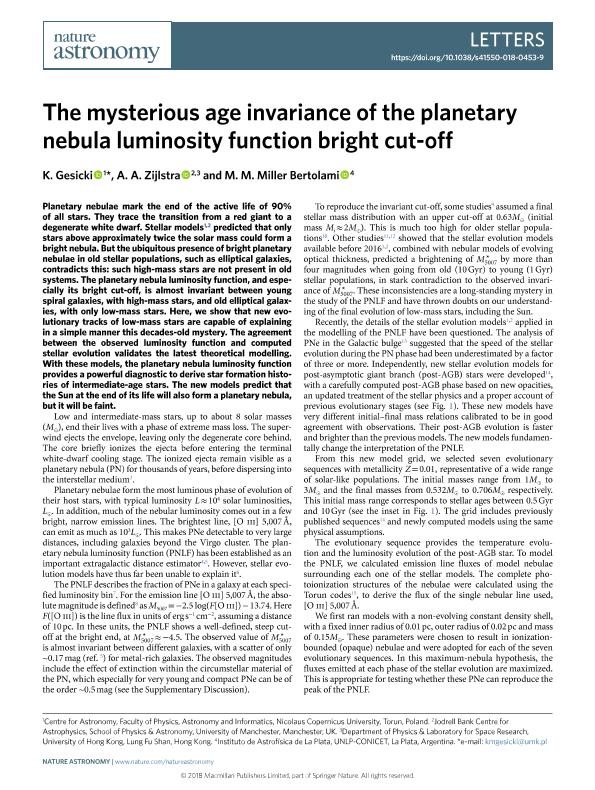Mostrar el registro sencillo del ítem
dc.contributor.author
Gesicki, K.
dc.contributor.author
Zijlstra, A.A.
dc.contributor.author
Miller Bertolami, Marcelo Miguel

dc.date.available
2019-08-29T16:07:09Z
dc.date.issued
2018-06
dc.identifier.citation
Gesicki, K.; Zijlstra, A.A.; Miller Bertolami, Marcelo Miguel; The mysterious age invariance of the planetary nebula luminosity function bright cut-off; Springer Nature; Nature Astronomy; 2; 7; 6-2018; 580-584
dc.identifier.issn
2397-3366
dc.identifier.uri
http://hdl.handle.net/11336/82487
dc.description.abstract
Planetary nebulae mark the end of the active life of 90% of all stars. They trace the transition from a red giant to a degenerate white dwarf. Stellar models predicted that only stars above approximately twice the solar mass could form a bright nebula. But the ubiquitous presence of bright planetary nebulae in old stellar populations, such as elliptical galaxies, contradicts this: Such high-mass stars are not present in old systems. The planetary nebula luminosity function, and especially its bright cut-off, is almost invariant between young spiral galaxies, with high-mass stars, and old elliptical galaxies, with only low-mass stars. Here, we show that new evolutionary tracks of low-mass stars are capable of explaining in a simple manner this decades-old mystery. The agreement between the observed luminosity function and computed stellar evolution validates the latest theoretical modelling. With these models, the planetary nebula luminosity function provides a powerful diagnostic to derive star formation histories of intermediate-age stars. The new models predict that the Sun at the end of its life will also form a planetary nebula, but it will be faint.
dc.format
application/pdf
dc.language.iso
eng
dc.publisher
Springer Nature

dc.rights
info:eu-repo/semantics/openAccess
dc.rights.uri
https://creativecommons.org/licenses/by-nc-sa/2.5/ar/
dc.subject
Interstellar Medium
dc.subject
Stellar Evolution
dc.subject.classification
Astronomía

dc.subject.classification
Ciencias Físicas

dc.subject.classification
CIENCIAS NATURALES Y EXACTAS

dc.title
The mysterious age invariance of the planetary nebula luminosity function bright cut-off
dc.type
info:eu-repo/semantics/article
dc.type
info:ar-repo/semantics/artículo
dc.type
info:eu-repo/semantics/publishedVersion
dc.date.updated
2019-08-23T17:43:49Z
dc.journal.volume
2
dc.journal.number
7
dc.journal.pagination
580-584
dc.journal.pais
Reino Unido

dc.journal.ciudad
Londres
dc.description.fil
Fil: Gesicki, K.. Nicolaus Copernicus University; Polonia
dc.description.fil
Fil: Zijlstra, A.A.. University of Manchester; Reino Unido
dc.description.fil
Fil: Miller Bertolami, Marcelo Miguel. Consejo Nacional de Investigaciones Científicas y Técnicas. Centro Científico Tecnológico Conicet - La Plata. Instituto de Astrofísica La Plata. Universidad Nacional de La Plata. Facultad de Ciencias Astronómicas y Geofísicas. Instituto de Astrofísica La Plata; Argentina
dc.journal.title
Nature Astronomy
dc.relation.alternativeid
info:eu-repo/semantics/altIdentifier/url/http://www.nature.com/articles/s41550-018-0453-9
dc.relation.alternativeid
info:eu-repo/semantics/altIdentifier/doi/http://dx.doi.org/10.1038/s41550-018-0453-9
Archivos asociados
